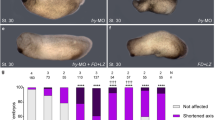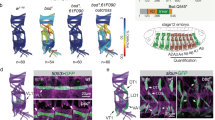Abstract
The establishment of polarity in many cell types depends on Lgl, the tumour suppressor product of lethal giant larvae, which is involved in basolateral protein targeting1,2,3,4. The conserved complex of Par3, Par6 and atypical protein kinase C5,6,7,8 phosphorylates and inactivates Lgl at the apical surface; however, the signalling mechanisms that coordinate cell polarization in development are not well defined. Here we show that a vertebrate homologue of Lgl associates with Dishevelled, an essential mediator of Wnt signalling, and that Dishevelled regulates the localization of Lgl in Xenopus ectoderm and Drosophila follicular epithelium. We show that both Lgl and Dsh are required for normal apical–basal polarity of Xenopus ectodermal cells. In addition, we show that the Wnt receptor Frizzled 8, but not Frizzled 7, causes Lgl to dissociate from the cortex with the concomitant loss of its activity in vivo. These findings suggest a molecular basis for the regulation of cell polarity by Frizzled and Dishevelled.
This is a preview of subscription content, access via your institution
Access options
Subscribe to this journal
Receive 51 print issues and online access
$199.00 per year
only $3.90 per issue
Buy this article
- Purchase on Springer Link
- Instant access to full article PDF
Prices may be subject to local taxes which are calculated during checkout




Similar content being viewed by others
References
Wodarz, A. Establishing cell polarity in development. Nature Cell Biol. 4, E39–E44 (2002)
Ohshiro, T., Yagami, T., Zhang, C. & Matsuzaki, F. Role of cortical tumour-suppressor proteins in asymmetric division of Drosophila neuroblast. Nature 408, 593–596 (2000)
Bilder, D., Li, M. & Perrimon, N. Cooperative regulation of cell polarity and growth by Drosophila tumour suppressors. Science 289, 113–116 (2000)
Musch, A. et al. Mammalian homolog of Drosophila tumour suppressor lethal (2) giant larvae interacts with basolateral exocytic machinery in Madin–Darby canine kidney cells. Mol. Biol. Cell 13, 158–168 (2002)
Etienne-Manneville, S. & Hall, A. Cdc42 regulates GSK-3β and adenomatous polyposis coli to control cell polarity. Nature 421, 753–756 (2003)
Benton, R. & St Johnston, D. Drosophila PAR-1 and 14–3-3 inhibit Bazooka/PAR-3 to establish complementary cortical domains in polarized cells. Cell 115, 691–704 (2003)
Chia, W. & Yang, X. Asymmetric division of Drosophila neural progenitors. Curr. Opin. Genet. Dev. 12, 459–464 (2002)
Ohno, S. Intercellular junctions and cellular polarity: the PAR–aPKC complex, a conserved core cassette playing fundamental roles in cell polarity. Curr. Opin. Cell Biol. 13, 641–648 (2001)
Shi, S. H., Jan, L. Y. & Jan, Y. N. Hippocampal neuronal polarity specified by spatially localized mPar3/mPar6 and PI 3-kinase activity. Cell 112, 63–75 (2003)
Nakaya, M. et al. Meiotic maturation induces animal-vegetal asymmetric distribution of aPKC and ASIP/PAR-3 in Xenopus oocytes. Development 127, 5021–5031 (2000)
Doe, C. Q. & Bowerman, B. Asymmetric cell division: fly neuroblast meets worm zygote. Curr. Opin. Cell Biol. 13, 68–75 (2001)
Plant, P. J. et al. A polarity complex of mPar-6 and atypical PKC binds, phosphorylates and regulates mammalian Lgl. Nature Cell Biol. 5, 301–308 (2003)
Betschinger, J., Mechtler, K. & Knoblich, J. A. The Par complex directs asymmetric cell division by phosphorylating the cytoskeletal protein Lgl. Nature 422, 326–330 (2003)
Yamanaka, T. et al. Mammalian Lgl forms a protein complex with PAR-6 and aPKC independently of PAR-3 to regulate epithelial cell polarity. Curr. Biol. 13, 734–743 (2003)
Hutterer, A., Betschinger, J., Petronczki, M. & Knoblich, J. A. Sequential roles of Cdc42, Par-6, aPKC, and Lgl in the establishment of epithelial polarity during Drosophila embryogenesis. Dev. Cell 6, 845–854 (2004)
Klezovitch, O., Fernandez, T. E., Tapscott, S. J. & Vasioukhin, V. Loss of cell polarity causes severe brain dysplasia in Lgl1 knockout mice. Genes Dev. 18, 559–571 (2004)
Lehman, K., Rossi, G., Adamo, J. E. & Brennwald, P. Yeast homologues of tomosyn and lethal giant larvae function in exocytosis and are associated with the plasma membrane SNARE, Sec9. J. Cell Biol. 146, 125–140 (1999)
Baas, A. F. et al. Complete polarization of single intestinal epithelial cells upon activation of LKB1 by STRAD. Cell 116, 457–466 (2004)
Eaton, S. Cell biology of planar polarity transmission in the Drosophila wing. Mech. Dev. 120, 1257–1264 (2003)
Mlodzik, M. Planar cell polarization: do the same mechanisms regulate Drosophila tissue polarity and vertebrate gastrulation? Trends Genet. 18, 564–571 (2002)
Tada, M. & Smith, J. C. Xwnt11 is a target of Xenopus Brachyury: regulation of gastrulation movements via Dishevelled, but not through the canonical Wnt pathway. Development 127, 2227–2238 (2000)
Wallingford, J. B. et al. Dishevelled controls cell polarity during Xenopus gastrulation. Nature 405, 81–85 (2000)
Cadigan, K. M. & Nusse, R. Wnt signalling: a common theme in animal development. Genes Dev. 11, 3286–3305 (1997)
Chalmers, A. D., Strauss, B. & Papalopulu, N. Oriented cell divisions asymmetrically segregate aPKC and generate cell fate diversity in the early Xenopus embryo. Development 130, 2657–2668 (2003)
Chalmers, A. D. et al. Crumbs3 and Lgl2 control apicobasal polarity in early vertebrate development. Development 132, 977–986 (2005)
Sheldahl, L. C. et al. Dishevelled activates Ca2+ flux, PKC, and CamKII in vertebrate embryos. J. Cell Biol. 161, 769–777 (2003)
Xu, T. & Rubin, G. M. Analysis of genetic mosaics in developing and adult Drosophila tissues. Development 117, 1223–1237 (1993)
Wu, J., Klein, T. J. & Mlodzik, M. Subcellular localization of frizzled receptors, mediated by their cytoplasmic tails, regulates signalling pathway specificity. PLoS Biol. 2, E158 (2004)
Bellaiche, Y., Beaudoin-Massiani, O., Stuttem, I. & Schweisguth, F. The planar cell polarity protein Strabismus promotes Pins anterior localization during asymmetric division of sensory organ precursor cells in Drosophila. Development 131, 469–478 (2004)
Brott, B. K. & Sokol, S. Y. A vertebrate homologue of the cell cycle regulator Dbf4 is a Wnt inhibitor required for heart development. Dev. Cell 8, 703–715 (2005)
Acknowledgements
We thank K. Itoh, J. Green, J. LeBlanc-Straceski, B. Lake and S. Dhawan for discussions and comments on the manuscript; J. Knoblich for anti-Lgl antibody; S. Citi for anti-occludin antibodies; A. Chalmers for the immunohistochemistry protocol; B. Brott for initial work on the yeast two-hybrid screen; and A. Djiane for help with the Drosophila studies. This work was supported by NIH grants (to S.Y.S. and M.M.) and an NIH training grant (to G.L.D.).
Author information
Authors and Affiliations
Corresponding author
Ethics declarations
Competing interests
Reprints and permissions information is available at npg.nature.com/reprintsandpermissions. The authors declare no competing financial interests.
Supplementary information
Supplementary Figures
This file contains Supplementary Figures 1–3. Supplementary Figure 1 demonstrates specificity of anti-Lgl antibodies using western analysis of Xenopus embryo lysates. Supplementary Figure 2 shows Dsh and Lgl constructs used in this study, and immunoprecipitation experiments demonstrating Dsh and Lgl interactions in vivo. Supplementary Figure 3 shows specific depletion of Lgl1 protein in stage 10 embryos upon injection of LglMO. (DOC 467 kb)
Rights and permissions
About this article
Cite this article
Dollar, G., Weber, U., Mlodzik, M. et al. Regulation of Lethal giant larvae by Dishevelled. Nature 437, 1376–1380 (2005). https://doi.org/10.1038/nature04116
Received:
Accepted:
Issue Date:
DOI: https://doi.org/10.1038/nature04116
This article is cited by
-
Planar cell polarity pathway in kidney development, function and disease
Nature Reviews Nephrology (2021)
-
Rspo2 inhibits TCF3 phosphorylation to antagonize Wnt signaling during vertebrate anteroposterior axis specification
Scientific Reports (2021)
-
Prickle3 synergizes with Wtip to regulate basal body organization and cilia growth
Scientific Reports (2016)
-
Par system components are asymmetrically localized in ectodermal epithelia, but not during early development in the sea anemone Nematostella vectensis
EvoDevo (2015)
-
EphrinB2 affects apical constriction in Xenopus embryos and is regulated by ADAM10 and flotillin-1
Nature Communications (2014)
Comments
By submitting a comment you agree to abide by our Terms and Community Guidelines. If you find something abusive or that does not comply with our terms or guidelines please flag it as inappropriate.



